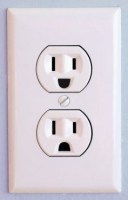What's the deal with Power Conditioners?
Here's the story of how I improved my home studio with the addition of a power conditioner. A power conditioner is one of those items that's probably pretty low on the things to buy list. If you have a home studio, or especially a live recording set-up, you should definitely consider getting one sooner, rather than later.So what is power conditioning?
Power conditioning is a kind of vague term to that
covers voltage regulation, surge protection, spike protection and noise
reduction of the AC power that runs all your equipment.
A power conditioner is a
rack that does all this as well as power distribution, a fancy word for
multiple outlets.
Samson PS15
The power conditioner I bought is a fairly simple
one, nothing fancy. It's the model PS15 from Samson that costs about $75.
This is one of the least expensive power conditioners you can get,
they can get pretty expensive and have all sorts of features that
likely won't help you make music. Mine has Eight outlets on the back,
one on the front, basic radio frequency filtering, surge and spike
protection and a circuit breaker to reset the system in case of
overload. No lights or meters, just a rack with a big red button that
no one is allowed to touch (one of my favorite features haha).
Filtering and Noise reduction
On
the topic of filtering and noise reduction. I haven't heard a change
in sound quality. Unless you have an obvious noise problem do not
expect any change. On the other hand, power conditioner will never add
noise to the system. The only time you might have noise is if you do
something like have one of your speakers on a different outlet, then
you might have some nasty ground loop hum.
Using it in the home studio
The way I have it set up is like this:All my computer equipment, computer, two monitors, modem, router and mouse charger go into a power bar and that takes up 1 outlet on the rack.
My audio gear plugs directly into the rack, that's my two Yamaha monitors, M-Audio Profire 2626 interface and vintage Roland Space Echo.
My hard drives and lighting for behind the desk go into another power bar and then into the rack.The charger for my Macbook Pro goes into the front.
Nine outlets is plenty, I
still have two left. The circuit breaker will trip to tell me when
I've used to much.
So why would you need a power conditioner?
These are the main factors
in my decision to purchase this power conditioner rack.
- My computer, monitors, speakers, interface, external drives and network take up a lot of outlets, more than is probably safe.
- I hate cable clutter, I wanted to separate audio and power cables but they'd always seem to cross because everything was going in opposite directions, now with the rack it's much more organized. I added some hooks to the back of the rack to keep the cables separated as much as possible.
- I'm in an apartment there's a good chance my power is erratic and noisy.
- I sometimes do mobile recording and this provides great protection for my gear.
- It was inexpensive.
- I had extra space in the rack.
- Rack gear is cool no matter what it does.
Your
reasons for getting one might be different. I think everyone can agree
it's essential for a live recording rig (who knows what's going on out
there). Better blowing up your power conditioner than your much more
valuable recording gear.
